- Home
- H. P. Lovecraft
Collected Fiction Volume 3 (1931-1936): A Variorum Edition Page 5
Collected Fiction Volume 3 (1931-1936): A Variorum Edition Read online
Page 5
Everyone,[525] of course, has read the brief and unsatisfying bulletins of the rest of our antarctic sojourn.[526] Some hours after our landing we sent a guarded report of the tragedy we found, and reluctantly announced the wiping out of the whole Lake party by the frightful wind of the preceding day, or of the night before that. Eleven known dead, young Gedney missing.[527] People pardoned our hazy lack of details through realisation[528] of the shock the sad event must have caused us, and believed us when we explained that the mangling action of the wind had rendered all eleven bodies unsuitable for transportation outside.[529] Indeed, I flatter myself that even in the midst of our distress, utter bewilderment, and soul-clutching horror, we scarcely went beyond the truth in any specific instance. The tremendous significance lies in what we dared not tell—[530]what I would not tell now but for the need of warning others off from nameless terrors.
It is a fact that the wind had wrought[531] dreadful havoc. Whether all could have lived through it, even without the other thing, is gravely open to doubt. The storm, with its fury of madly driven ice-particles,[532] must have been beyond anything our expedition had encountered before.[533] One aëroplane shelter—all, it seems, had been left in a far too flimsy and inadequate state—was nearly pulverised;[534] and the derrick at the distant boring was entirely shaken to pieces.[535] The exposed metal of the grounded planes and drilling machinery was bruised into a high polish, and two of the small tents were flattened despite their snow banking. Wooden surfaces left out in the blast[536] were pitted and denuded of paint, and all signs of tracks in the snow were completely obliterated.[537] It is also true that we found none of the archaean[538] biological objects in a condition to take outside as a whole. We did gather some minerals from a vast[539] tumbled pile, including several of the greenish soapstone fragments whose odd five-pointed rounding and faint patterns of grouped dots caused so many doubtful comparisons;[540] and some fossil bones, among which were the most typical of the curiously injured specimens.[541]
None of the dogs survived, their hurriedly built snow enclosure[542] near the camp being almost wholly destroyed. The wind may have done that, though the greater breakage[543] on the side next the camp, which was not the windward one, suggests an outward leap or break of the frantic beasts themselves.[544] All three sledges were gone, and we have tried to explain that the wind may have blown them off into the unknown. The drill and ice-melting machinery at the boring were too badly damaged to warrant salvage, so we used them to choke up that subtly disturbing gateway to the past which Lake had blasted.[545] We likewise left at the camp the two most shaken-up[546] of the planes; since our surviving party had only four real pilots—Sherman, Danforth, McTighe, and Ropes—in all, with Danforth in a poor nervous shape to navigate. We brought back all the books, scientific equipment, and other incidentals we could find, though much was rather unaccountably blown away. Spare tents and furs were either missing or badly out of condition.
It was approximately 4 p.m.,[547] after wide plane cruising had forced us to give Gedney up for lost, that we sent our guarded message to the Arkham for relaying; and I think we did well to keep it as calm and non-committal[548] as we succeeded in doing.[549] The most we said about agitation concerned[550] our dogs, whose frantic uneasiness near the biological specimens was to be expected from poor Lake’s accounts. We did not mention, I think, their display of the same uneasiness when sniffing around the queer greenish soapstones and certain other objects in the disordered region;[551] objects including scientific instruments, aëroplanes, and machinery[552] both at the camp and at the boring, whose parts had been loosened, moved, or otherwise tampered with by winds that must have harboured[553] singular curiosity and investigativeness.
About the fourteen biological specimens we were pardonably indefinite. We said that the only ones we discovered were damaged, but that enough was left of them to prove Lake’s description wholly and impressively accurate. It was hard work keeping our personal emotions out of this matter—and we did not mention numbers or say exactly how we had found those which we did find. We had by that time agreed not to transmit anything suggesting madness on the part of Lake’s men, and it surely looked like madness to find six imperfect monstrosities carefully buried upright in nine-foot snow graves under five-pointed mounds punched over with groups of dots in patterns exactly like[554] those on the queer greenish soapstones dug up from Mesozoic or Tertiary[555] times. The eight perfect specimens mentioned by Lake seemed to have been completely[556] blown away.
We were careful, too, about the public’s general peace of mind; hence Danforth and I said little about that frightful trip over the mountains the next day. It was the fact that only a radically lightened plane could possibly cross a range of such height which mercifully limited that scouting tour to the two of us.[557] On our return at 1 a.m.[558] Danforth was close to hysterics, but kept an admirably stiff upper lip. It took no persuasion to make him promise not to shew[559] our sketches and the other things we brought away in our pockets, not to say anything more to the others than what we had agreed to relay outside, and to hide our camera films for private development later on; so that part of my present story will be as new to Pabodie, McTighe, Ropes, Sherman, and the rest as it will be to the[560] world in general. Indeed—[561]Danforth is closer-mouthed[562] than I;[563] for he saw—or thinks he saw—[564]one thing he will not tell even me.
As all know, our report included a tale of a hard ascent;[565] a confirmation of Lake’s opinion that the great peaks are of archaean[566] slate and other very primal crumpled strata unchanged since at least middle Comanchian times;[567] a conventional comment on the regularity of the clinging cube and rampart formations;[568] a decision that the cave-mouths[569] indicate dissolved calcareous veins;[570] a conjecture that certain slopes and passes would permit of the scaling and crossing of the entire range by seasoned mountaineers;[571] and a remark that the mysterious other side holds a lofty and immense super-plateau[572] as ancient and unchanging as the mountains themselves—20,000[573] feet in elevation, with grotesque rock formations protruding through a thin glacial layer and with low gradual foothills between the general plateau surface and the sheer precipices of the highest peaks.
This body of data is in every respect true so far as it goes, and it completely satisfied the men at the camp. We laid our absence of sixteen hours—a longer time than our announced flying, landing, reconnoitring,[574] and rock-collecting programme[575] called for—to a long mythical spell of adverse wind conditions;[576] and told truly of our landing on the farther foothills.[577] Fortunately our tale sounded realistic and prosaic enough not to tempt any of the others into emulating our flight. Had any tried to do that, I would have used every ounce of my persuasion to stop them—and I do not know what Danforth would have done.[578] While we were gone, Pabodie, Sherman, Ropes, McTighe, and Williamson had worked like beavers over Lake’s two best planes;[579] fitting them again for use[580] despite the altogether unaccountable juggling of their operative mechanism.
We decided to load all the planes the next morning and start back for our old base as soon as possible. Even though indirect, that was the safest way to work toward McMurdo Sound; for a straight-line[581] flight across the most utterly unknown stretches of the aeon-dead continent would involve many additional hazards.[582] Further exploration was hardly feasible in view of our tragic decimation and the ruin of our drilling machinery; and the[583] doubts and horrors around us—which we did not reveal—made us wish only to escape from this austral world of desolation and brooding madness as swiftly as we could.
As the public knows, our return to the world was accomplished without further disasters. All planes reached the old base on the evening of the next day—January 27th[584]—after a swift non-stop[585] flight; and on the 28th we made McMurdo Sound in two laps, the one pause being very brief, and occasioned by a faulty rudder[586] in the furious wind over the ice-shelf [587] after we had cleared the great plateau.[588] In five days more[589] the Arkham and Misk
atonic, with all hands and equipment on board, were shaking clear of the thickening field ice and working up Ross Sea[590] with the mocking mountains of Victoria Land looming westward against a troubled antarctic sky and twisting the wind’s wails into a wide-ranged musical piping which chilled my soul to the quick.[591] Less than a fortnight later we left the last hint of polar land behind us,[592] and thanked heaven that we were clear of a haunted, accursed realm where life and death, space and time, have made black and blasphemous alliances in the unknown epochs since matter first writhed and swam on the planet’s scarce-cooled crust.
Since our return we have all constantly worked to discourage antarctic exploration, and have kept certain doubts and guesses to ourselves with splendid unity and faithfulness. Even young Danforth, with his nervous breakdown, has not flinched or babbled to his doctors—indeed,[593] as I have said, there is one thing he thinks he alone saw which he will not tell even me, though I think it would help his psychological state if he would consent to do so. It might explain and relieve much, though perhaps the thing was no more than the delusive aftermath of an earlier shock. That is the impression I gather after those rare[594] irresponsible moments when he whispers disjointed things to me—things which he repudiates vehemently as soon as he gets a grip on himself again.
It will be hard work deterring others from the great white south, and some of our efforts may directly harm our cause by drawing inquiring notice. We might have known from the first that human curiosity is undying, and that the results we announced would be enough to spur others ahead on the same age-long pursuit of the unknown.[595] Lake’s reports of those biological monstrosities had aroused naturalists and palaeontologists to the highest pitch;[596] though we were sensible enough not to shew[597] the detached parts we had taken from the actual buried specimens, or our photographs of those specimens as they were found. We also refrained from shewing[598] the more puzzling of the scarred bones and greenish soapstones; while Danforth and I have closely guarded the pictures we took or drew on the super-plateau[599] across the range, and the crumpled things we smoothed, studied in terror, and brought away in our pockets.[600] But now that Starkweather-Moore party is organising,[601] and with a thoroughness far beyond anything our outfit attempted. If [602] not dissuaded, they will get to the innermost nucleus of the antarctic and melt and bore till they bring up that which may end the world we know.[603] So I must break through all reticences at last—even about that ultimate[604] nameless thing beyond the mountains of madness.
IV.
It is only with vast hesitancy and repugnance that I let my mind go back to Lake’s camp and what we really found there—and to that other thing beyond the frightful mountain wall.[605] I am constantly tempted to shirk the details, and to let hints stand for actual facts and ineluctable deductions. I hope I have said enough already to let me glide briefly over the rest; the rest, that is, of the horror at the camp.[606] I have told of the wind-ravaged[607] terrain, the damaged shelters, the disarranged machinery, the varied uneasinesses[608] of our dogs, the missing sledges and other items, the deaths of men and dogs, the absence of Gedney, and the six insanely buried biological specimens, strangely sound in texture for all their structural injuries, from a world forty million years dead. I do not recall whether I mentioned that upon checking up the canine bodies we found one dog missing. We did not think much about that till later—indeed, only Danforth and I have thought of it at all.
The principal things I have been keeping back relate to the bodies, and to certain subtle points which may or may not lend a hideous and incredible kind of rationale to the apparent chaos.[609] At the time[610] I tried to keep the men’s minds off those points; for it was so much simpler—so much more normal—to lay everything to an outbreak of madness on the part of some of Lake’s party. From the look of things, that daemon[611] mountain wind must have been enough to drive any man mad in the midst of this centre[612] of all earthly mystery and desolation.
The crowning abnormality, of course, was the condition of the bodies—men and dogs alike. They had all been in some terrible kind of conflict, and were torn and mangled in fiendish and altogether inexplicable ways. Death, so far as we could judge, had in each case come from strangulation or laceration.[613] The dogs had evidently started the trouble, for the state of their ill-built corral bore witness to its forcible breakage from within. It had been set some distance from the camp because of the hatred of the animals for those hellish archaean[614] organisms, but the precaution seemed to have been taken in vain. When left alone in that monstrous wind behind flimsy walls of insufficient height[615] they must have stampeded—whether from the wind itself, or from some subtle, increasing odour[616] emitted by the nightmare specimens, one could not say. Those specimens, of course, had been covered with a tent-cloth; yet the low antarctic sun had beat steadily upon that cloth, and Lake had mentioned that solar heat tended to make the strangely sound and tough tissues of the things relax and expand. Perhaps the wind had whipped the cloth from over them, and jostled them about in such a way that their more pungent olfactory qualities became manifest despite their unbelievable antiquity.[617]
But whatever had happened, it was hideous and revolting enough. Perhaps I had better put squeamishness aside and tell the worst at last—though with a categorical statement of opinion, based on the first-hand observations and most rigid deductions of both Danforth and myself, that the then missing Gedney was in no way responsible for the loathsome horrors we found.[618] I have said that the bodies were frightfully mangled. Now I must add that some were incised and subtracted from in the most curious, cold-blooded, and inhuman fashion. It was the same with dogs and men. All the healthier, fatter bodies, quadrupedal or bipedal, had had their most solid masses of tissue cut out and removed, as by a careful butcher; and around them was a strange sprinkling of salt—taken from the ravaged provision-chests[619] on the planes—which conjured up the most horrible associations.[620] The thing had occurred in one of the crude aëroplane shelters from which the plane had been dragged out, and subsequent winds had effaced all tracks which could have supplied any plausible theory. Scattered bits of clothing, roughly slashed from the human incision-subjects,[621] hinted no clues.[622] It is useless to bring up the half-impression[623] of certain faint snow-prints[624] in one shielded corner of the ruined enclosure[625]—because that impression did not concern human prints at all, but was clearly mixed up with all the talk of fossil prints which poor Lake had been giving throughout the preceding weeks. One had to be careful of one’s imagination in the lee of those overshadowing mountains of madness.
As I have indicated, Gedney and one dog turned out to be missing in the end. When we came on that terrible shelter we had missed two dogs and two men; but the fairly unharmed dissecting tent, which we entered after investigating the monstrous graves, had something to reveal.[626] It was not as Lake had left it, for the covered parts of the primal monstrosity had been removed from the improvised table. Indeed, we had already realised[627] that one of the six imperfect and insanely buried things we had found—the one with the trace of a peculiarly hateful odour[628]—must represent the collected sections of the entity which Lake had tried to analyse.[629] On and around that laboratory table were strown[630] other things, and it did not take long for us to guess that those things were the carefully[631] though oddly and inexpertly dissected parts of one man and one dog. I shall spare the feelings of survivors by omitting mention of the man’s identity.[632] Lake’s anatomical instruments were missing, but there were evidences of their careful cleansing. The gasoline stove was also gone, though around it we found a curious litter of matches. We buried the human parts beside the other ten men, and the canine parts with the other 35[633] dogs. Concerning the bizarre smudges on the laboratory table, and on the jumble of roughly handled illustrated books scattered near it, we were much too bewildered to speculate.
This formed the worst of the camp horror, but other things were equally perplexing. The disappearance of Gedney, t
he one dog, the eight uninjured biological specimens, the three sledges, and certain instruments, illustrated technical and scientific books, writing materials, electric torches and batteries, food and fuel, heating apparatus, spare tents, fur suits, and the like, was utterly beyond sane conjecture; as were likewise the spatter-fringed ink-blots[634] on certain pieces of paper, and the evidences of curious alien fumbling and experimentation around the planes and all other mechanical devices both at the camp and at the boring. The dogs seemed to abhor this oddly disordered machinery.[635] Then, too, there was the upsetting of the larder, the disappearance of certain staples, and the jarringly comical heap of tin cans pried open in the most unlikely ways and at the most unlikely places. The profusion of scattered matches, intact, broken, or spent, formed another minor enigma;[636] as did the two or three tent-cloths[637] and fur suits which we found lying about with peculiar and unorthodox slashings conceivably due to clumsy efforts at unimaginable adaptations.[638] The maltreatment of the human and canine bodies, and the crazy burial of the damaged archaean[639] specimens, were all of a piece with this apparent disintegrative madness. In view of just such an eventuality as the present one, we carefully photographed all the main evidences of insane disorder at the camp; and shall use the prints to buttress our pleas against the departure of the proposed Starkweather-Moore Expedition.
Our first act after finding the bodies in the shelter was to photograph and open the row of insane graves with the five-pointed snow mounds. We could not help noticing the resemblance of these monstrous mounds, with their clusters of grouped dots, to poor Lake’s descriptions of the strange greenish soapstones; and when we came on some of the soapstones themselves in the great mineral pile we found the likeness very close indeed.[640] The whole general formation, it must be made clear, seemed abominably suggestive of the starfish-head[641] of the archaean[642] entities; and we agreed that the suggestion must have worked potently upon the sensitised[643] minds of Lake’s overwrought party. Our own first sight of the actual buried entities formed a horrible moment, and sent the imaginations of Pabodie and myself back to some of the shocking primal myths we had read and heard. We all agreed that the mere sight and continued presence of the things must have coöperated with the oppressive polar solitude and daemon mountain wind in driving Lake’s party mad.[644]

 The Best of H.P. Lovecraft
The Best of H.P. Lovecraft The Definitive H.P. Lovecraft: 67 Tales Of Horror In One Volume
The Definitive H.P. Lovecraft: 67 Tales Of Horror In One Volume The Complete Works of H.P. Lovecraft
The Complete Works of H.P. Lovecraft Other Gods and More Unearthly Tales
Other Gods and More Unearthly Tales Lovecraft's Fiction Volume I, 1905-1925
Lovecraft's Fiction Volume I, 1905-1925 The Shadow Out of Time
The Shadow Out of Time The Shunned House
The Shunned House Lovecraft's Fiction Volume II, 1926-1928
Lovecraft's Fiction Volume II, 1926-1928 The Thing on the Doorstep and Other Weird Stories
The Thing on the Doorstep and Other Weird Stories Dream Cycle of H. P. Lovecraft: Dreams of Terror and Death
Dream Cycle of H. P. Lovecraft: Dreams of Terror and Death Great Tales of Horror
Great Tales of Horror Shadows of Death
Shadows of Death Delphi Complete Works of H. P. Lovecraft (Illustrated)
Delphi Complete Works of H. P. Lovecraft (Illustrated) Waking Up Screaming: Haunting Tales of Terror
Waking Up Screaming: Haunting Tales of Terror H.P. Lovecraft Goes to the Movies
H.P. Lovecraft Goes to the Movies The Road to Madness
The Road to Madness The Complete H.P. Lovecraft Reader (68 Stories)
The Complete H.P. Lovecraft Reader (68 Stories) The Horror in the Museum
The Horror in the Museum Collected Fiction Volume 1 (1905-1925): A Variorum Edition
Collected Fiction Volume 1 (1905-1925): A Variorum Edition Lovecrafts_Fiction, vol.I_1905-1925
Lovecrafts_Fiction, vol.I_1905-1925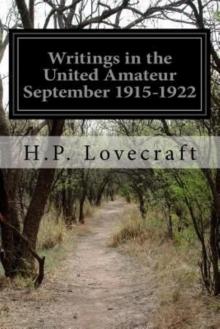 Writings in the United Amateur, 1915-1922
Writings in the United Amateur, 1915-1922 H.P. Lovecraft: The Complete Works
H.P. Lovecraft: The Complete Works Collected Fiction Volume 3 (1931-1936): A Variorum Edition
Collected Fiction Volume 3 (1931-1936): A Variorum Edition H.P. Lovecraft: The Complete Fiction
H.P. Lovecraft: The Complete Fiction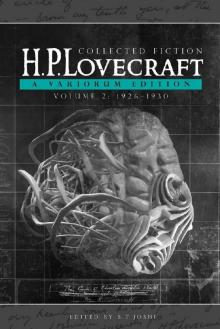 Collected Fiction Volume 2 (1926-1930): A Variorum Edition
Collected Fiction Volume 2 (1926-1930): A Variorum Edition Yog Sothothery - The Definitive H.P. Lovecraft Anthology
Yog Sothothery - The Definitive H.P. Lovecraft Anthology The Complete H.P. Lovecraft Collection (Xist Classics)
The Complete H.P. Lovecraft Collection (Xist Classics)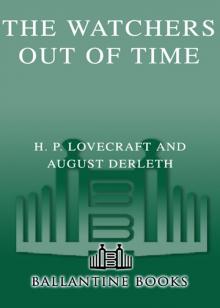 The Watchers Out of Time
The Watchers Out of Time Eldritch Tales
Eldritch Tales The Other Gods And More Unearthly Tales
The Other Gods And More Unearthly Tales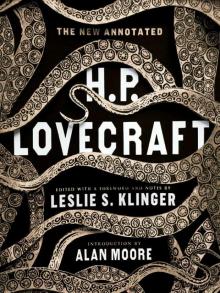 The New Annotated H. P. Lovecraft
The New Annotated H. P. Lovecraft At the mountains of madness
At the mountains of madness Bloodcurdling Tales of Horror and the Macabre
Bloodcurdling Tales of Horror and the Macabre Fossil Lake II: The Refossiling
Fossil Lake II: The Refossiling Shadows of Carcosa: Tales of Cosmic Horror by Lovecraft, Chambers, Machen, Poe, and Other Masters of the Weird
Shadows of Carcosa: Tales of Cosmic Horror by Lovecraft, Chambers, Machen, Poe, and Other Masters of the Weird H. P. Lovecraft
H. P. Lovecraft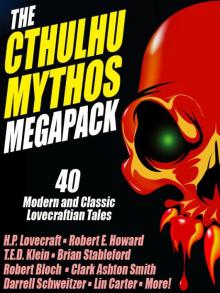 The Cthulhu Mythos Megapack
The Cthulhu Mythos Megapack The Complete H. P. Lovecraft Reader (2nd Edition)
The Complete H. P. Lovecraft Reader (2nd Edition) The Complete Fiction
The Complete Fiction Waking Up Screaming
Waking Up Screaming Transition of H. P. Lovecraft
Transition of H. P. Lovecraft![[1935] The Shadow Out of Time Read online](http://i1.bookreadfree.com/i2/04/12/1935_the_shadow_out_of_time_preview.jpg) [1935] The Shadow Out of Time
[1935] The Shadow Out of Time The Horror Megapack
The Horror Megapack